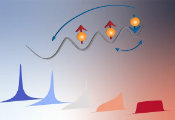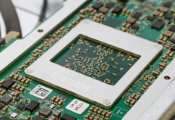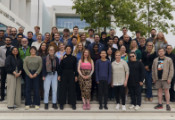3D-Printed Polymer Wires Enhance Quantum Light Technology
May 21 2025 -- One of the major hurdles in quantum technology is efficiently collecting and directing individual particles of light, called single photons. Single photons are useful because they can serve as fundamental units of quantum information. The existing systems for handling single photons generally rely on semiconductor-based methods that often impose design requirements that limit their flexibility and the ability to scale the technology to larger systems that can be easily produced.
A new study led by the groups of JQI Fellow Kartik Srinivasan and Luca Sapienza, a university associate professor in quantum engineering at the University of Cambridge, has introduced an innovative method for improving single-photon collection—an essential step in advancing secure communications, high-precision imaging and quantum computing. In February 2025, they shared the research in the journal Advanced Quantum Technologies, which featured the research on its cover.
“Extracting the single photons generated by semiconductor quantum dots into a useful transmission channel like an optical fiber is known to be essential for communication and networking applications of this type of source,” says Srinivasan, who is also a Fellow of the National Institute of Standards and Technology. “Our new work addresses this challenge by using a photonic structure that is designed to maximize overlap with optical fibers, and a fabrication approach that enables it to be added onto existing quantum dot photon source geometries.”
Srinivasan and Sapienza’s research overcomes the limitations of the established semiconductor-based methods by leveraging the three-dimensional fabrication capabilities of a process called direct laser writing. Direct laser writing works like 3D printing to build structures layer by layer. But instead of laying down material, it uses precisely controlled lasers to trigger a chemical reaction in a small volume of a viscous liquid so that the exposed region becomes a solid structure. Any unchanged material is eventually washed away. By building up section by section, researchers can craft complex structures with incredibly small details. In the paper, the team describes how they used the technique to make polymer nanowires that are only about one micrometer wide—about the width of a bacteria or a single strand of spider silk.
The researchers demonstrated that nanowires formed using the technique enhances photon extraction from quantum emitters—light sources—while also preserving the performance of the emitters, making them highly suitable for integration into existing photonic networks.
“Our approach allows for a more efficient coupling of quantum light into optical fibers, which is a crucial step in transferring quantum information,” Sapienza says. “Polymer nanowires offer significant advantages—they are easy to fabricate, provide broad operational bandwidth, and offer greater design flexibility than other solutions currently available.”
A Step Toward Scalable Quantum Technologies
The researchers also partnered some of their new nanowires with nanorings—similarly tiny rings of metal. Placing a gold nanoring around a quantum emitter at the base of the wire increased how efficiently the photons are captured as they are produced. Prior experiments performed by the researchers showed that metallic nanorings can allow the collection of more than seven million photons per second. In the new experiment, they demonstrated an approximately threefold increase in the rate at which they detected photons when they added a polymer nanowire to a gold nanoring, marking a significant step forward in the efficient collection and manipulation of quantum light.
Conventional semiconductor-based nanowires require complex fabrication and often suffer from structural instability and other issues. The polymer-based approach offers several advantages. It improves photon collection by guiding single photons into well-defined optical modes—distinct ways that light can propagate through a system—that are optimized for fiber coupling. The fabrication process makes it easier to reliably make many nanowires, enabling high-yield production of single-mode nanowires. Additionally, the 3D-printing capability provides design flexibility, allowing precise tailoring of nanowire geometry to suit different quantum applications.
Future Applications and Collaborations
Srinivasan and Sapienza are optimistic that their findings will find a wide-ranging of applications. This technology could potentially be used to efficiently handle single photons in quantum communication networks, next-generation imaging systems, and quantum computing architectures, so it could help develop the future of quantum technologies along multiple fronts.
“This combined, hybrid, semiconductor-metal-polymer technology can represent a key step toward the realization of scalable, bright quantum light sources, which are fundamental to most quantum technologies,” Sapienza says.
The authors say the result has already attracted interest from both academic and industrial sectors, with potential collaborations on the horizon to explore real-world implementations of this technology.
With the increasing demand for efficient and scalable quantum devices, this advance in 3D-printed photonic structures signals an exciting future for quantum engineering and its practical applications across various fields.




































